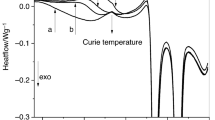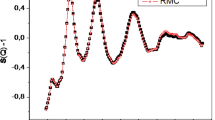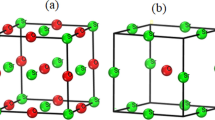Abstract
The possibility of calculating the thermodynamic properties of glasses and melts in the Cs2O-B2O3-SiO2 system formed by two glass-former oxides and one modifier oxide with the use of the vacancy variant of the generalized lattice theory of associated solutions is demonstrated. A comparison with the experimental thermodynamic functions determined earlier by high-temperature differential mass spectrometry and electromotive force method shows that the calculations performed within this approach lead to reliable thermodynamic functions. The thermodynamic properties and structural features (the relative numbers of bonds with due regard for the second coordination sphere) of glasses and melts in the Cs2O-B2O3-SiO2 system are analyzed in terms of the generalized lattice theory of associated solutions.
Similar content being viewed by others
References
Smirnova, N.A., Molekulyarnye teorii rastvorov (Molecular Theories of Solutions), Leningrad: Khimiya, 1987.
Stolyarova, V.L. and Semenov, G.A., Mass Spectrometric Study of Vaporization Processes of Oxide Systems, Chichester: Wiley, 1994.
Barker, J.A. and Smith, F., Statistical Thermodynamics of Associated Solutions, J. Chem. Phys., 1954, vol. 22, no. 3, pp. 375–380.
Kozhina, E.L. and Shultz, M.M., Thermodynamic Properties of Cesium Borate and Cesium Borosilicate Melts, Proceedings of the XVIII Internationa Congress on Glass, San Francisco, 1998, CD-ROM, p. AB89.
Stolyarova, V.L., Lopatin, S.I., Belousova, O.L., and Grishchenko, L.V., Phase Equilibria and Thermodynamic Properties of Components in the Cs2O-B2O3-SiO2 System at High Temperatures, Fiz. Khim. Stekla, 2006, vol. 32, no. 1, pp. 80–89 [Glass Phys. Chem. (Engl. transl.), 2006, vol. 32, no. 1, pp. 55–62].
Shultz, M.M., Ivanov, G.G., Stolyarova, V.L., and Shakhmatkin, B.A., Thermodynamic Properties of Melts and Glasses in the B2O3-SiO2 System, Fiz. Khim. Stekla, 1986, vol. 12, no. 3, pp. 285–292.
Shultz, M.M., Stolyarova, V.L., and Ivanov, G.G., Thermodynamic Properties of Melts and Glasses in the GeO2-SiO2 System, Fiz. Khim. Stekla, 1987, vol. 13, no. 6, pp. 830–838.
Shultz, M.M., Ivanov, G.G., Stolyarova, V.L., and Shakhmatkin, B.A., Calculation of Thermodynamic Properties of Glass-Forming Melts in the B2O3-GeO2 and B2O3-SiO2 Systems, Fiz. Khim. Stekla, 1986, vol. 12, no. 4, pp. 385–390.
Stolyarova, V.L., Shornikov, S.I., Ivanov, G.G., and Shultz, M.M., High Temperature Mass Spectrometric Study of Thermodynamic Properties of the CaO-SiO2 System, J. Electrochem. Soc., 1991, vol. 138, no. 12, pp. 3710–3714.
Stolyarova, V.L., Ivanov, G.G., and Shultz, M.M., Mass Spectrometric Study of the Thermodynamic Properties of Melts in the B2O3-GeO2-SiO2 System, Fiz. Khim. Stekla, 1991, vol. 17, no. 5, pp. 689–697.
Plotnikov, E.N. and Stolyarova, V.L., Calculations of the Thermodynamic Properties of Glasses and Melts in the Na2O-SiO2 and B2O3-SiO2 Systems on the Basis of the Generalized Lattice Theory of Associated Solutions, Fiz. Khim. Stekla, 2005, vol. 31, no. 6, pp. 1048–1086 [Glass Phys. Chem. (Engl. transl.), 2005, vol. 31, no. 6, pp. 763–788].
Ortega, J. and Rheinboldt, W., Interative Solution of Non-linear Equations of Several Variables, New York: McGraw-Hill, 1970. Translated under the title Iteratsionnye metody resheniya nelineinykh system uravnenii so mnogimi neizvestnymi, Moscow: Mir, 1975.
Samarskii, A.A. and Gulin, A.V., Chislennye metody (Numerical Methods), Moscow: Nauka, 1989.
Voevodin, V.V., Chislennye metody algebry: teoriya i algoritmy (Numerical Methods in Algebra: Theory and Algorithms), Moscow: Nauka, 1966.
Mazurin, O.V., Strel’tsina, M.V., and Shvaiko-Shvaikovskaya, T.P., Svoistva stekol i stekloobrazuyushchikh rasplavov (Properties of Glasses and Glass-Forming Melts), Leningrad: Nauka, 1977, vol. 3.
Stolyarova, V.L., Lopatin, S.I., Sycheva, G.A., and Plotnikov, E.N., Mass Spectrometric Study of the Thermodynamic Properties of Melts in the Cs2O-B2O3 System, Fiz. Khim. Stekla, 2005, vol. 31, no. 6, pp. 1087–1098 [Glass Phys. Chem. (Engl. transl.), 2005, vol. 31, no. 6, pp. 789–798].
Stolyarova, V.L., Lopatin, S.I., and Plotnikov, E., Thermodynamic Properties and Vaporization Processes of Ternary Glass-Forming Silicate Systems: CaO-Al2O3-SiO2, CaO-TiO2-SiO2, and BaO-TiO2-SiO2, Proceedings of the VII ESC Conference on Glass Science and Technology, Athens, 2004, pp. 32–35.
Bank dannykh termodinamicheskikh velichin IVTANTERMO. Elektronnaya versiya (IVTANTERMO Database on Thermodynamic Quantities: Electronic Version), 1980, Table 540; 1982, Tables 1239, 1269.
Wagner, C., Thermodynamics of Alloys, Cambridge: Addison-Wesley, 1952. Translated under the title Termodinamika splavov, Moscow: Metallurgiya, 1957.
Author information
Authors and Affiliations
Additional information
Original Russian Text © E.N. Plotnikov, V.L. Stolyarova, 2006, published in Fizika i Khimiya Stekla.
Rights and permissions
About this article
Cite this article
Plotnikov, E.N., Stolyarova, V.L. Calculations of the thermodynamic properties of glasses and melts in the Cs2O-B2O3-SiO2 system in the framework of the generalized lattice theory of associated solutions. Glass Phys Chem 32, 181–190 (2006). https://doi.org/10.1134/S1087659606020106
Received:
Issue Date:
DOI: https://doi.org/10.1134/S1087659606020106




